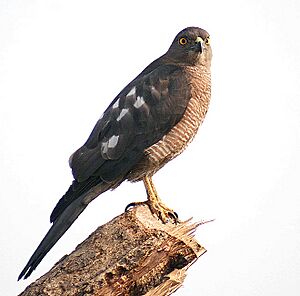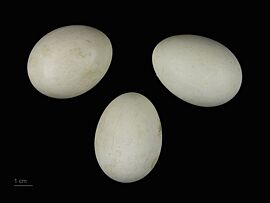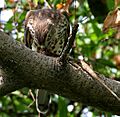Shikra facts for kids
Quick facts for kids Shikra |
|
|---|---|
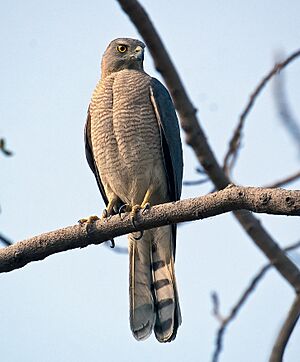 |
|
| Adult female (dussumieri) |
|
| Conservation status | |
| Scientific classification | |
| Genus: |
Accipiter
|
| Species: |
badius
|
| Subspecies | |
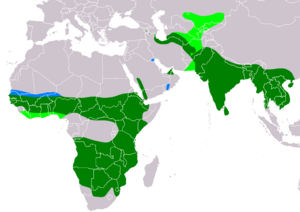 |
|
| Range of A. badius Breeding Resident Non-breeding | |
| Synonyms | |
|
Astur badius |
|
The shikra (Accipiter badius) is a small bird of prey. It belongs to the Accipitridae family, which includes eagles and hawks. You can find shikras in many parts of Asia and Africa. In Africa, it's sometimes called the little banded goshawk.
Shikras look and act a lot like other Accipiter birds. These include the Chinese goshawk and the Eurasian sparrowhawk. Shikras make a sharp, two-note call. They fly by flapping their wings and then gliding. Other birds, like drongos, sometimes copy their calls.
Contents
Shikra's Scientific Name and Family Tree
The shikra got its official scientific name in 1788. A German scientist named Johann Friedrich Gmelin described it. He first put it in the Falco group. This group includes eagles and other hawks. Its scientific name, Falco badius, means "brown falcon."
Later, the shikra was moved to the Accipiter group. This group was named by a French zoologist in 1760. The word Accipiter is Latin for "hawk." It comes from a word meaning "to grasp," which makes sense for a bird of prey! The word badius means "chestnut-colored" or "brown."
Different Types of Shikras: Subspecies
Scientists have found six different types, or subspecies, of shikras. These types live in different parts of the world:
- A. b. sphenurus: Found from Senegal to Arabia, down to Tanzania.
- A. b. polyzonoides: Lives in southern Africa, from Congo to South Africa.
- A. b. cenchroides: Found from the Caucasus mountains to Central Asia and northwest India.
- A. b. dussumieri: Lives in central India and Bangladesh.
- A. b. poliopsis: Found from northern India to southern China and Sumatra.
- A. b. badius: This is the original type, found in southwest India and Sri Lanka.
Some of these subspecies, like the one in Myanmar (A. b. poliopsis), might even be their own separate species!
What Does a Shikra Look Like?
The shikra is a small bird of prey, about 26 to 30 centimeters long. Like other Accipiter hawks, it has short, rounded wings. Its tail is narrow and a bit long.
Adult shikras have white undersides with thin reddish-brown stripes. Their upper parts are grey. The lower belly has fewer stripes, and their thighs are whitish.
Differences Between Male and Female Shikras
- Males have bright red eyes.
- Females have eyes that are less red, more yellowish-orange. They also have brownish upper parts and more stripes on their undersides. Females are usually a bit bigger than males.
When a male shikra flies, you can see its light-colored underwings. Its wingtips are blackish. The tail feathers have faint bands, but the middle tail feathers usually don't have bands, just a dark tip.
Young Shikras and Their Calls
Young shikras have dark streaks and spots on their upper chest. Their wings have narrow bands, and their tails have dark, thin bands.
The shikra's call sounds like "pee-wee." The first note is higher, and the second one is longer. When they are flying, their calls are shorter and sharper, like "kik-ki... kik-ki."
Shikra Habits and Home
Shikras live in many different places. You can find them in forests, on farms, and even in cities. They usually fly alone or in pairs. They often soar high on warm air currents and dive at each other during breeding season.
When a shikra flies by, smaller birds and squirrels often make alarm calls.
What Do Shikras Eat?
Shikras are hunters! They eat:
- Small animals like rodents and squirrels.
- Small birds.
- Small reptiles, mostly lizards, but sometimes small snakes.
- Insects, like winged termites.
They might even hunt small bats at dusk. Sometimes, they've been seen eating dead animals, which is rare for them. Other birds, like drongos, sometimes copy the shikra's call. This might help the drongos steal food by making other birds think a predator is near.
How Shikras Hunt and Interact
Smaller birds often try to hide in leaves to escape a shikra. One small blue kingfisher was even seen diving into water to get away! Groups of babblers have been seen working together to chase a shikra away.
Shikra Reproduction and Life Cycle
In India, shikras usually breed in the summer, from March to June. They build a nest that looks like a platform, similar to a crow's nest. They line it with grass. Both the male and female help build the nest, carrying twigs with their feet. Sometimes, they even use metal wires!
A female shikra usually lays 3 to 4 eggs. The eggs are pale bluish-grey with black speckles at the wider end. If eggs are removed, she might lay more. Some observers have seen a female lay as many as 7 eggs in one season! The eggs hatch in about 18 to 21 days.
Shikras in Culture
The shikra was a very popular bird for falconers in India and Pakistan. Falconers are people who train birds of prey to hunt. Shikras were easy to train. They were often used to catch food for more valuable falcons. People admired their bravery and their ability to catch birds much larger than themselves, like partridges or even young peafowl.
The word shikra comes from the Hindi language. It means "hunter." The male shikra was sometimes called chipak or chipka because of its call. The word shikra also comes from the Urdu word "shikari," which means hunter.
A famous Punjabi poet, Shiv Kumar Batalvi, wrote a poem about a lost love. In the poem, called "Main Ik Shikra Yaar Banaya," he compares his lost love to a shikra.
Gallery



